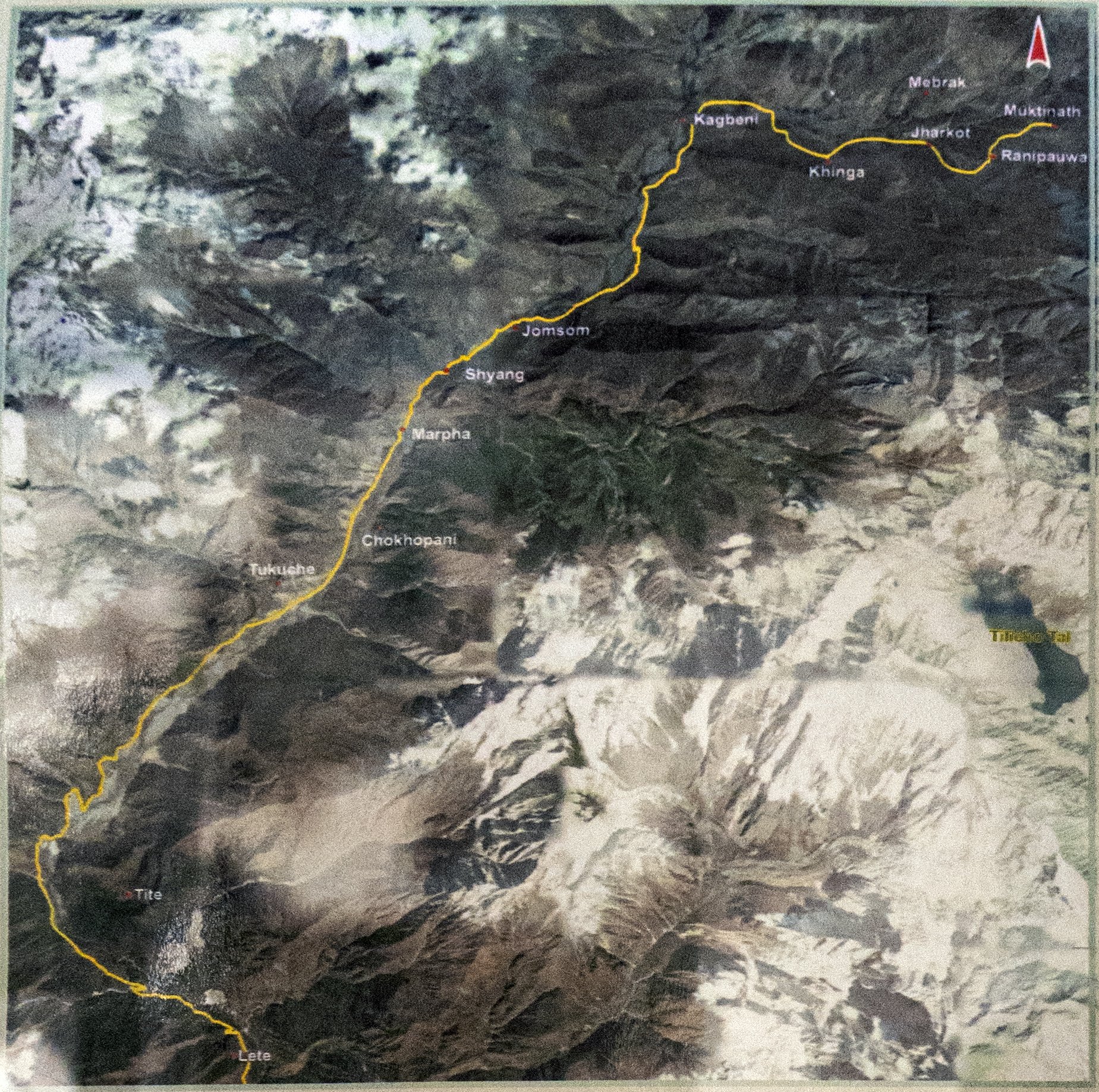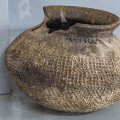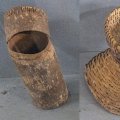Nepal: Natural History Gallery: photo 66
Photo 66 of 71 in Gallery: Nepal: Natural History Gallery

Image title: Mustang (central Nepal)
Description of the photo
Main description:
Mustang is the trans-himalayan river valley located in central Nepal drained by the River Kaligandaki. The valley is traversed by the people since prehistoric times linking the Gangetic plains of south and Brahmaputra Valley of Tibetan plateau who travel to and from either sides with the aim of pilgrimage as well as trade purpose.
All the visitors and pilgrims trekking to Muktinath were and are always amazed to see big holes on the cliffs all along the way. But very few of them think what that is? what was that for? who made them and when were they made and for how long were they used for?
Thousands of pilgrims for hundreds of years saw the holes, but curiosity remained always as silent as ever before. The burial caves were exposed while a shaft was being dug to install the water pipe for mini-hydro project in Chokhopani terrace across the Kaligandaki river from Tukuche village. It was on Friday the 6th November in 1981. The burial caves, later on proved to be older than three thousand years.
Virtually there are hundreds of cave concentrations and thousands of caves hewn out in them. Millions of people must have used them for thousands of years during the course of historic time. This was the history of Mustang archaeology that started by chance as in other important archaeological sites of the world: the Mohenjo-daro of Pakistan, Lascaux of France and terracotta army of Xian, China.
Few of the amazing finds are exhibited in two showcases one with organic artifacts and next one with potteries. The organic artifacts also are preserved due to the arid climate in the region. The bamboo baskets and other artifacts dates from the start of Christian Era to sixteenth century AD.
Nepalese text (not proofread):
मध्यनेपालको उत्तरी भागमा पर्ने हिमालयश्रृंखलालाई वारपार छिचोलेर बसेको जिल्ला मुस्ताङ हो । कालीगण्डकी नदीले यस जिल्लाको जलप्रवाहको साथै गंगा (जमुनाको मैदानी फाँट र हिमालयपारिका ब्रम्हपुत्र उपत्यका बीच तीर्थयात्री र व्यापारीहरूलाई आवागमन मार्गको समेत काम गर्दै आएको छ ।
कालीगण्डकी नदी किनारा हुँदै मुक्तिक्षेत्रको भ्रमण गर्ने तीर्थयात्री र व्यापारका निम्ति तिब्बती पठार पुग्ने बटुवाहरू कालीगण्डकी तथा त्यसका सहायक नदीका दुवैपट्टिका भीरहरूमा देखिने ठूला ठूला दुलाहरू के होलान् ? कसले, कहिले के प्रयोजनका लागि बिनलाई बनाए होलान् भनेर आश्चर्यमा पर्ने गर्दथे । हजारौं वर्षदेखि लाखौं मानिसहरूमा उब्जेका यस्ता जिज्ञासाहरू अनुत्तरित नै रहेका थिए । तर २०३८ सालमा मुस्ताङको टुकुचे गाउँको चोखोपानी भन्ने ठाउँको भीरमा साना जलविद्युत योजनाका लागि पाइपलाइन खन्ने क्रममा संयोगवश, केही चिहानगुफाहरू र मृतकसँगै गाडिएका विभिन्न सामग्रीहरू फेला परे ।
पाकिस्तानको मोहनजोदारो, फ्रान्सको लास्कागुफा, चीनको सियान माटाका सैनिक सहितको चिहानस्थल जस्तै अचानक संयोगवश, प्राचीन अवशेषहरू फेला परेको मुस्ताङको यस घटना पछि तल्लो मुस्ताङ क्षेत्रका चोखोपानी, मेब्राक, झोङका भीरहरूमा अवस्थित गुफाहरू र आसपासका खिझ, फुजलिङ लगायतका प्राचीन भग्नावशेषहरूको पुराताविक उत्खनन र अध्ययन गरिएको थियो । जसबाट आजभन्दा तीनहजार वर्ष पहिलेतिर देखि यस क्षेत्रमा बसोबास गर्ने मानिसहरूले गुफाहरू खनेर आफ्ना लागि आवास र आफ्ना मृतकका लागि चिहानका रूपमा प्रयोग गर्ने गरेका थिए भन्ने कुरा प्रमाणित हुन आएको छ । फलस्वरूप वर्षो अघिदेखि यस क्षेत्रको भ्रमण गर्ने तीर्थयात्री एवं बटुवाहरूको कालीगण्डकी आसपासका भीरमा देखिने ठूला ठूला दुलाहरू बारेको कौतुहल एवं जिज्ञासाहरूको पनि जवाफ मिलेको छ ।
तल्लो मुस्ताङ क्षेत्रको पुराताविक उत्खनन् एवं अध्ययनका क्रममा प्राप्त केही पुराताविक वस्तुहरू यस प्रदर्शन कक्ष (ग्यालरी) मा रहेका २ वटा शोकेसहरूमा राखिएका छन् । एउटा शोकेसमा प्राारिक वस्तुबाट बनेका सामग्रीहरू र अर्कोमा माटाका भाँडावर्तनहरू प्रदर्शित छन् । मुस्ताङ जिल्लाको चिसो र सुख्खा हावापानीका कारण प्राारिक वस्तुबाट बनेका सामग्रीहरू ई.पू. चौथो शताब्दीतिरदेखि इशाको १६ औं शताब्दीसम्मका अर्थात् हजारौं वर्ष पुराना भए पनि पूर्णरूपमा सुरक्षित अवस्थामा रहेको पाइएको छ ।
English translation (automated):
Mustang is a district scattered across the Himalayan range in the northern part of central Nepal. The Kaligandaki River has been serving as the water flow of this district as well as the movement route for pilgrims and traders between the plains of the Jamuna and the Himalayan Brahmaputra Valley.
Pilgrims who visit Mukti Kshetra passing through Kaligandaki River and pilgrims who reach the Tibetan Plateau for business, what are the big dulas seen on both sides of Kaligandaki and its tributaries? They used to wonder who made the bin, when and for what purpose. For thousands of years, millions of people had such questions that remained unanswered. But in the year 2038, while digging a pipeline for a small hydropower project in Bhir, a place called Chokhopani of Tukuche village in Mustang, some tombs and various materials buried with the dead were accidentally discovered.
After this incident of Mustang, where ancient remains were found suddenly by chance, such as Mohenjodaro in Pakistan, Laskagufa in France, China's Xian Mata soldier's grave, the caves located in Chokhopani, Mebrak, Zhong Bhir in the lower Mustang region and the surrounding ancient ruins including Khij, Fujling were excavated and studied. From which it has been proven that the people living in this area used to dig caves and use them as residences and graves for their dead from three thousand years ago. As a result, the curiosity and inquiries of the pilgrims and pilgrims visiting this area since last year have been answered.
Some of the archaeological objects obtained during the archaeological excavations and studies of Lower Mustang area are kept in 2 showcases in this exhibition room (gallery). Materials made from natural materials are displayed in one showcase and pottery in the other. Due to the cold and dry climate of Mustang district, materials made from natural materials were produced in BC. From the 4th century to the 16th century of Isha, i.e. thousands of years old, it has been found to be in a completely safe condition.
Transcription:
madhyanepālako uttarī bhāgamā parne himālayaśrṛṃkhalālāī vārapāra chicolera baseko jillā mustāṅa ho . Kālīgaṇḍakī nadīle yasa jillāko jalapravāhako sāthai gaṃgā (jamunāko maidānī phāṃṭa ra himālayapārikā bramhaputra upatyakā bīca tīrthayātrī ra vyāpārīharūlāī āvāgamana mārgako sameta kāma gardai āeko cha .
kālīgaṇḍakī nadī kinārā huṃdai muktikṣetrako bhramaṇa garne tīrthayātrī ra vyāpārakā nimti tibbatī paṭhāra pugne baṭuvāharū kālīgaṇḍakī tathā tyasakā sahāyaka nadīkā duvaipaṭṭikā bhīraharūmā dekhine ṭhūlā ṭhūlā dulāharū ke holān ? kasale, kahile ke prayojanakā lāgi binalāī banāe holān bhanera āścaryamā parne gardathe . Hajārauṃ varṣadekhi lākhauṃ mānisaharūmā ubjekā yastā jijñāsāharū anuttarita nai rahekā thie . Tara 2038 sālamā mustāṅako ṭukuce gāuṃko cokhopānī bhanne ṭhāuṃko bhīramā sānā jalavidyuta yojanākā lāgi pāipalāina khanne kramamā saṃyogavaśa, kehī cihānaguphāharū ra mṛtakasaṃgai gāḍiekā vibhinna sāmagrīharū phelā pare .
pākistānako mohanajodāro, phrānsako lāskāguphā, cīnako siyāna māṭākā sainika sahitako cihānasthala jastai acānaka saṃyogavaśa, prācīna avaśeṣaharū phelā pareko mustāṅako yasa ghaṭanā pachi tallo mustāṅa kṣetrakā cokhopānī, mebrāka, jhoṅakā bhīraharūmā avasthita guphāharū ra āsapāsakā khijha, phujaliṅa lagāyatakā prācīna bhagnāvaśeṣaharūko purātāvika utkhanana ra adhyayana garieko thiyo . Jasabāṭa ājabhandā tīnahajāra varṣa pahiletira dekhi yasa kṣetramā basobāsa garne mānisaharūle guphāharū khanera āphnā lāgi āvāsa ra āphnā mṛtakakā lāgi cihānakā rūpamā prayoga garne garekā thie bhanne kurā pramāṇita huna āeko cha . Phalasvarūpa varṣo aghidekhi yasa kṣetrako bhramaṇa garne tīrthayātrī evaṃ baṭuvāharūko kālīgaṇḍakī āsapāsakā bhīramā dekhine ṭhūlā ṭhūlā dulāharū bāreko kautuhala evaṃ jijñāsāharūko pani javāpha mileko cha .
tallo mustāṅa kṣetrako purātāvika utkhanan evaṃ adhyayanakā kramamā prāpta kehī purātāvika vastuharū yasa pradarśana kakṣa (gyālarī) mā rahekā 2 vaṭā śokesaharūmā rākhiekā chan . Euṭā śokesamā prāाrika vastubāṭa banekā sāmagrīharū ra arkomā māṭākā bhāṃḍāvartanaharū pradarśita chan . Mustāṅa jillāko ciso ra sukhkhā hāvāpānīkā kāraṇa prāाrika vastubāṭa banekā sāmagrīharū ī.pū. Cautho śatābdītiradekhi iśāko १६ auṃ śatābdīsammakā arthāt hajārauṃ varṣa purānā bhae pani pūrṇarūpamā surakṣita avasthāmā raheko pāieko cha .
Transcription:
madhyanepalako uttari bhagama parne himalayashrrimkhalalai varapara chicolera baseko jilla mustana ho . kaligandaki nadile yasa jillako jalapravahako sathai gamga (jamunako maidani phamta ra himalayaparika bramhaputra upatyaka bica tirthayatri ra vyapariharulai avagamana margako sameta kama gardai aeko cha .
kaligandaki nadi kinara humdai muktikshetrako bhramana garne tirthayatri ra vyaparaka nimti tibbati pathara pugne batuvaharu kaligandaki tatha tyasaka sahayaka nadika duvaipattika bhiraharuma dekhine thula thula dulaharu ke holan ? kasale, kahile ke prayojanaka lagi binalai banae holan bhanera ashcaryama parne gardathe . hajaraum varshadekhi lakhaum manisaharuma ubjeka yasta jijnasaharu anuttarita nai raheka thie . tara 2038 salama mustanako tukuce gaumko cokhopani bhanne thaumko bhirama sana jalavidyuta yojanaka lagi paipalaina khanne kramama samyogavasha, kehi cihanaguphaharu ra mritakasamgai gadieka vibhinna samagriharu phela pare .
pakistanako mohanajodaro, phransako laskagupha, cinako siyana mataka sainika sahitako cihanasthala jastai acanaka samyogavasha, pracina avasheshaharu phela pareko mustanako yasa ghatana pachi tallo mustana kshetraka cokhopani, mebraka, jhonaka bhiraharuma avasthita guphaharu ra asapasaka khijha, phujalina lagayataka pracina bhagnavasheshaharuko puratavika utkhanana ra adhyayana garieko thiyo . jasabata ajabhanda tinahajara varsha pahiletira dekhi yasa kshetrama basobasa garne manisaharule guphaharu khanera aphna lagi avasa ra aphna mritakaka lagi cihanaka rupama prayoga garne gareka thie bhanne kura pramanita huna aeko cha . phalasvarupa varsho aghidekhi yasa kshetrako bhramana garne tirthayatri evam batuvaharuko kaligandaki asapasaka bhirama dekhine thula thula dulaharu bareko kautuhala evam jijnasaharuko pani javapha mileko cha .
tallo mustana kshetrako puratavika utkhanan evam adhyayanaka kramama prapta kehi puratavika vastuharu yasa pradarshana kaksha (gyalari) ma raheka 2 vata shokesaharuma rakhieka chan . euta shokesama praाrika vastubata baneka samagriharu ra arkoma mataka bhamdavartanaharu pradarshita chan . mustana jillako ciso ra sukhkha havapanika karana praाrika vastubata baneka samagriharu i.pu. cautho shatabditiradekhi ishako १६ aum shatabdisammaka arthat hajaraum varsha purana bhae pani purnarupama surakshita avasthama raheko paieko cha .
Gallery information:
The Natural History Gallery includes rare exhibitions of various animals and objects relating to natural science. It also includes a doll sectiondisplaying the ancient lifestyle and attire of people from around the world. The items found here are exhibited in the National Museum of Nepal (Rashtriya Museum).
Photo details:
Date: 2019-12-04
Camera: SONY ILCE-6400
Exposure: 1/60
Aperture: f/3.5
ISO: 1600
Focal length: 18mm
High resolution:
Download file
Size: 2.13 MB
Resolution: 1849 x 1837
© Photograph by Gabe Hiemstra.
License: CC BY-NC-ND 4.0

